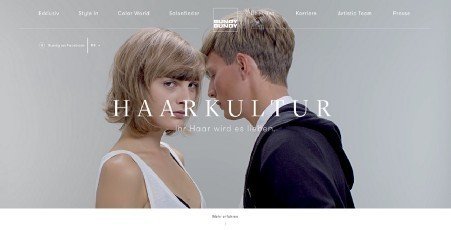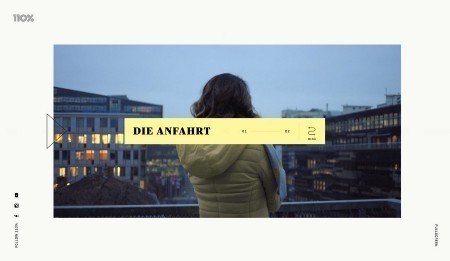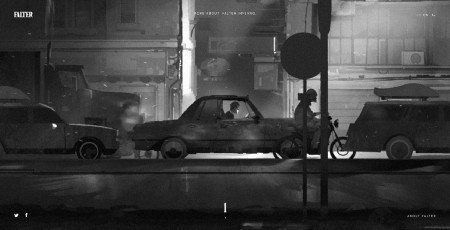
“There is a reason why we keep our team quite small” — by WILD <vol.3>
We interviewed WILD, a digital branding studio based in Vienna, Austria. Last year they won three Cannes Lions and a Webby for Falter’s Inferno , as well as Site of the Year at Awwwards. We asked them how they usually execute their projects and how they collaborate with their clients to create a good product.
Question 1:
Please tell us about your company.
WILD is based in Vienna/Austria and it founded roughly 2.5 years ago. Our company started with 4 members who were all coming from a freelance background and we decided that it would be a good idea to found a company together. At the moment we are a total of 10 people and we still all fit around one table for lunch!


Photo of their office just after they moved in
Question 2:
Please tell us about the characteristics of your clients.
We started off with a lot of international clients such as Adidas, Intel, Acura or Al Gore. We were able bring those projects into the company mainly through contacts from our freelance time. After a while, we were able to build a larger reputation in Austria and and we are now working with a growing amount of local clients, which we really enjoy!
Question 3:
You are saying that international and local clients are fifty-fifty, but these two kinds of clients have very distinct characteristics, I guess. How do you handle this?
Most international clients usually have some kind of past experience towards digital products. Whereas most local clients are not as familiar with the concept. So often, we need to first show them what is actually possible and after our work is done, their view towards digital experiences has often changed.
Question 4:
How do you decide which project to take?
We decide which projects to take based on how well we get along with the client. Literally, if we have the feeling we “get” each other. Of course, budget also plays a certain role in these decisions, but there have been some projects where we just loved the idea or product and wanted to create something awesome.
We actually never took a job simply based on the commission and are planning to continue like this. This has worked out great in the past; probably because we are still quite a small team of 10 people.

Question 5:
When your team start a new project, what work process do your team member follow?
Usually when we get a brief for a new project, one of our 4 founding members takes the lead in client communication and project management. In addition, this person will also be in charge for tech or art direction lead depending on the background, assemble the team and work out timeline and budget.
Our proposal style is very simple: we like to show rather than tell. We try to create animated mock-ups and mood boards and present them to the client. Especially for local clients, it is easier to visualize the possibilities and mood with mock-ups, since it not only helps them imagine the end product, but also helps us conduct our projects with greater confidence.
Question 6:
Please tell us about the tools used in your office.
We use ‘Slack’ for in house communication, ‘Flow’ for project management because its simple and efficient and tools like ‘Adobe After Effects’ ,’Sketch’ , ‘WebStorm’. And of course, ‘Spotify’ because we like to always have some music playing in the background.
Question 7:
Over the course of a week, on average, how many overtime hours does a team member work?
When it was only the 4 of us, we were used to working without considering normal working hours, but after hiring our first employee we really started to focus on better project management so that everyone would be able to go home at a reasonable hour.
Right now, overtime doesn’t really exist anymore. Of course, every now and then someone will be motivated to finish a task before leaving and stay an hour longer. But we’ve made the experience that if people have time for their social lives and are well rested, they are way more productive. Most of the time, that extra hour they would stay in the office isn’t as efficient as one expects.
For this reason, when creating the timeline for a project we make sure to plan enough buffer time in order to avoid any late night work sessions.

Question 8:
In what ways does your company provide a good working environment for employees?
We try to have a “WILD day” every month where we do something different each time. In the past we played board games, laser tag, had a bbq on the rooftop or went curling. Curling is awesome by the way! But in general, we try to design the office space as a place where employees can also relax and play dart or playstation if they need a break.
Question 9:
Does your company allow employees to have second jobs?
If someone is passionate about something, we definitely encourage them to explore the possibilities and potential for a personal project. And sometimes, this eventually results in a side project for WILD.
Question 10:
Finally, what as a company do you believe is the most important requirement for doing “good work?”
We think there are two important requirements: skills and motivation. We are very open about passing on everything we know about development and design to improve our employees skills, but they also have to be motivated to learn, play with new tech and design ideas all the time and apply that knowledge. I think because we all love what we do, we automatically create good work.

Latest works of WILD







This article was published at the time of release in March 2017.
WILD’s SNS account
Facebook / Twitter / Instagram
Click here for previous articles
Follow us!

